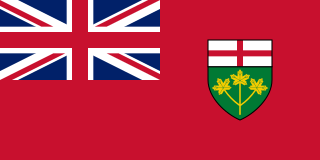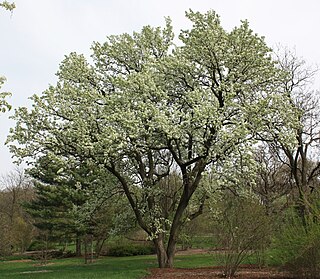Related Research Articles

Lake Ontario is one of the five Great Lakes of North America. It is surrounded on the north, west, and southwest by the Canadian province of Ontario, and on the south and east by the U.S. state of New York, whose water boundaries meet in the middle of the lake. Ontario, Canada's most populous province, was named for the lake.

Ontario is one of the thirteen provinces and territories of Canada. Located in Central Canada, it is Canada's most populous province, with 38.3 percent of the country's population, and is the second-largest province by total area. Ontario is Canada's fourth-largest jurisdiction in total area when the territories of the Northwest Territories and Nunavut are included. It is home to the nation's capital city, Ottawa, and the nation's most populous city, Toronto, which is also Ontario's provincial capital.

Pears are fruits produced and consumed around the world, growing on a tree and harvested in late Summer into October. The pear tree and shrub are a species of genus Pyrus, in the family Rosaceae, bearing the pomaceous fruit of the same name. Several species of pears are valued for their edible fruit and juices, while others are cultivated as trees.

An orchard is an intentional plantation of trees or shrubs that is maintained for food production. Orchards comprise fruit- or nut-producing trees which are generally grown for commercial production. Orchards are also sometimes a feature of large gardens, where they serve an aesthetic as well as a productive purpose. A fruit garden is generally synonymous with an orchard, although it is set on a smaller non-commercial scale and may emphasize berry shrubs in preference to fruit trees. Most temperate-zone orchards are laid out in a regular grid, with a grazed or mown grass or bare soil base that makes maintenance and fruit gathering easy.

Pyrus pyrifolia is a species of pear tree native to East Asia. The tree's edible fruit is known by many names, including: Asian pear, Japanese pear, Chinese pear, Korean pear, Taiwanese pear, apple pear, zodiac pear, three-halves pear, papple and sand pear. Along with cultivars of P. × bretschneideri and P. ussuriensis, the fruit is also called the nashi pear. Cultivars derived from Pyrus pyrifolia are grown throughout East Asia, and in other countries such as India, Australia, New Zealand, and the United States. Traditionally in East Asia the tree's flowers are a popular symbol of early spring, and it is a common sight in gardens and the countryside.

A wildflower is a flower that grows in the wild, meaning it was not intentionally seeded or planted. The term implies that the plant probably is neither a hybrid nor a selected cultivar that is in any way different from the way it appears in the wild as a native plant, even if it is growing where it would not naturally. The term can refer to the flowering plant as a whole, even when not in bloom, and not just the flower.

Pyrus calleryana, or the Callery pear, is a species of pear tree native to China and Vietnam, in the family Rosaceae. It is most commonly known for its cultivar 'Bradford', widely planted throughout the United States and increasingly regarded as an invasive species.

Pyrus communis, known as the European pear or common pear, is a species of pear native to central and eastern Europe and southwest Asia.

Vineland is an unincorporated community within the Town of Lincoln in Niagara Region. Located in the Canadian province of Ontario, it is bordered by the Twenty Mile Creek and Jordan to the east, Lake Ontario to the north, Beamsville to the west, and Pelham to the south. Vineland is primarily an agricultural community, and is home to many tender fruit farms and wineries. As the second-largest community in the Town of Lincoln, Vineland's small commercial centre along King Street serves the surrounding communities of Campden and Jordan. Post office established in 1894.

The Beurre Bosc or Bosc is a cultivar of the European pear from France or Belgium originally. Also known as the Kaiser, it is grown in Europe, Australia, British Columbia and Ontario, Canada, and the northwestern U.S. states of California, Washington, and Oregon.
Honda of Canada Manufacturing is located in Alliston, Ontario and is the automobile manufacturing division of Honda Canada Inc.

'Ambrosia' is a cultivar of apple originating in British Columbia in the early 1990s. The original tree was first cultivated by the Mennell family of Similkameen Valley, British Columbia, who discovered it growing in their orchard.

Eglinton Park is a public park located in the North Toronto neighbourhood of Toronto, Ontario, Canada, a few blocks west of the Eglinton Subway Station. It is bounded on the south end by Eglinton Avenue West, on the north by Roselawn Aveunue. The other two sides of the park have houses backing onto the park; Oriole Parkway on the west side, and Edith Drive on the east.

The Williams' bon chrétien pear, commonly called the Williams pear, or the Bartlett pear in the United States and Canada, is the most commonly grown variety of pear in most countries outside Asia.
Cecil Frederick Patterson (1891–1961) was renowned in Saskatchewan for his work on hardy fruits and flowers.

Opuntia humifusa, commonly known as the devil's-tongue, Eastern prickly pear or Indian fig, is a cactus of the genus Opuntia present in parts of eastern North America.

Opuntia fragilis, known by the common names brittle pricklypear and little prickly pear, is a prickly pear cactus native to much of western North America as well as some midwestern states such as Illinois, Iowa, Wisconsin and Michigan. It also occurs in several Canadian provinces. It is known from farther north than any other cactus, occurring at as far as 56°N latitude in British Columbia. There is an isolated and possibly genetically unique population in Eastern Ontario known as the "Kaladar population".

Opuntia, commonly called prickly pear, is a genus of flowering plants in the cactus family Cactaceae. Prickly pears are also known as tuna (fruit), sabra, nopal from the Nahuatl word nōpalli for the pads, or nostle, from the Nahuatl word nōchtli for the fruit; or paddle cactus. The genus is named for the Ancient Greek city of Opus, where, according to Theophrastus, an edible plant grew and could be propagated by rooting its leaves. The most common culinary species is the Indian fig opuntia.

Canadian General Electric was a Canadian manufacturer of various electrical products. It was the Canadian counterpart of the American company General Electric. The unit became General Electric Canada in 1989, and is now known as GE Canada.
References
- ↑ HortScience August 2009 vol. 44 no. 5 1461-1463
